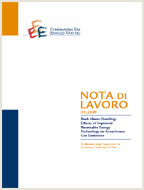Solving the Clinker Dilemma with Hybrid Output-based Allocation

Data
21.10.2015
21.10.2015
Autori
Frédéric Branger (CIRED, AgroParistech ENGREF); Misato Sato (LSE)
Codice JEL
Q50, Q54, H23
Q50, Q54, H23
Parole chiave:
Emissions Trading, Output-based Allocation, Climate Policy, Cement sector, Clinker Dilemma
Emissions Trading, Output-based Allocation, Climate Policy, Cement sector, Clinker Dilemma
Publisher
Climate Change and Sustainable Development
Climate Change and Sustainable Development
Editor
Carlo Carraro
Carlo Carraro
This paper proposes an innovative solution to distribute free allowances to the cement sector under emissions trading systems, called hybrid output-based allocation (OBA). We demonstrate that unlike many of the allocation methods currently being used, our design provides incentives which are aligned with the mitigation options available to this sector in the short to medium term. Specifically, it increases the incentive to improve the carbon intensity of clinker production; reduces the incentive to import clinker to avoid carbon costs; increases the incentive to use more low-carbon clinker alternatives to produce cement; and finally it reduces excess allocation and reduces incentives to inflate production volumes to obtain more free allowances. The hybrid OBA does not, however, provide incentives to reduce the consumption of cement or to bring about break-through technologies, hence should be considered as a mid-term solution to aid the decarbonization of the cement sector in conjunction with other support mechanisms.
***
Suggested citation: Branger, F., M. Sato, (2015), ‘Solving the Clinker Dilemma with Hybrid Output-based Allocation’, Nota di Lavoro 85.2015, Milan, Italy: Fondazione Eni Enrico Mattei.
